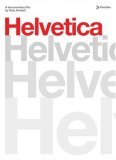Design Talk for Non-Designers Too

This has been a great year for works about graphic design that offer entertainment and insight for not only for designers but for the rest of us.
The most extraordinary example is Helvetica, a delightful documentary about the 20th-century's most ubiquitous typeface. It's also about modernism, postmodernism, and whatever came after--and about the eternal aesthetic tension between the classic and the expressive. The film made the festival circuit last year, including a stop in Dallas, and director Gary Huswit has been nominated for an Independent Spirit Award. The film also deserves an Oscar nod. It's now out on DVD. I'll have an interview with Hustwit on The Atlantic's website next month.
I'm also a big fan of Michael Bierut's Seventy-Nine Short Essays on Design, many of which originally appeared as longish blog postings on Design Observer. As my niece Rachel, now a design student at Carnegie Mellon, said, "He's so funny." (His moment in Helvetica brought down the house.) He's also charming and smart. Here's a passage from essay 11 that should interest plenty of readers who think they don't care about graphic design:
I just reread The Fountainhead, and I was curious to see how fifteen years of work in the real world would change my take on it. The book is viewed with, at best, kindly derision by most practicing architects and designers I know. But Roark's view toward clients still seems to describe the secret yearning harbored by most of my fellow professionals whether they care to admit it or not; they too might declare, "I don't intend to build in order to have clients. I intend to have clients in order to build."
I was also reminded again how simple the world of design was in 1943, when the book was published. In the tenth grade, when I read Roark's declaration that "A house can have integrity, just like a person, and just as seldom." I could clearly imagine the kind of house he was talking about; it looked like the pictures I had seen of Fallingwater. I had yet to read Complexity and Contradiction in Modern Architecture, which would confuse things a bit by making a fairly persuasive case for things like blue metal balconies.
What surprised me most were the descriptions of the compromises Roark was asked to make. When I read these at twenty, they seemed like impossibly grotesque caricatures: surely simpering clients didn't actually babble nonsense like, "Our conservatives simply refused to accept a queer stark building like yours. And they claim that the public won't accept it either. So we hit on a middle course. In this way, though it's not traditional architecture of course it will give the public the impression of what they're accustomed to. It adds a certain air of sound, stable dignity...." Today this sounds exactly like the kind of quite reasonable stuff I listen thoughtfully to and--God help me--acquiesce to, every day. And at this I began to feel a little depressed.
The book's version of the essay is better, but you can read the original blog post here.
Michael Bierut is one of the prominent graphic designers interviewed in How to Think Like a Great Graphic Designer by Debbie Millman, a branding consultant who hosts a weekly Internet radio program called "Design Matters." (I've been a guest.) Reading a book, I was struck by how it portrayed, through graphic designers, the life of anyone engaged in creative work, particularly those of us who tend toward the unbalanced life. You can read a review of the book here.